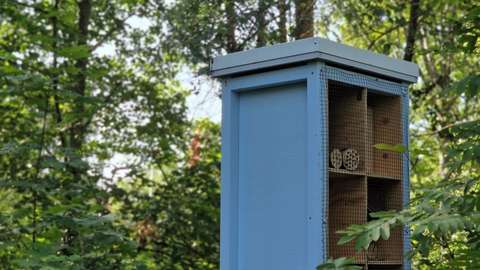Otaniemi is buzzing – bees are mapping biodiversity

A cooperation project is under way on the Otaniemi campus as pollinators have been harnessed to map the biodiversity of the city. Bees collect valuable environmental data along with pollen, which can be used to assess the diversity of vegetation in the area and the success of the control of non-native species.
The Otaniemi campus is buzzing when bees start their work. A joint project of the City of Espoo, Senate Properties, Aalto University and the HumbleBee Housing Project has built a beehive tower in the area for pollinators who collect DNA material from the surrounding nature for biomonitoring. The aim is to map the diversity of food plants in the campus area, as well as to monitor the occurrence of non-native species and endangered plants.
However, the bees primarily live an ordinary bee life on the campus – collecting samples takes place at the same time as they fly from flower to flower, pollinating plants while looking for food. Using environmental DNA samples collected from the hive, pollinator-collected pollen provides valuable information on plant species in the area, including those that would otherwise not be easily detected. At the same time, the effectiveness of the control of non-native species can be assessed. “We would love it if people could see the role of pollinators as more active participants in the development of the urban environment rather than as passive sufferers,” says Aapo Reuter from the HumbleBee Housing Project.
The beehive tower was brought to the Aalto University campus at the end of April. In May, the first bees to enter the hives were red mason bees, and in June, they were joined by buff-tailed bumblebees. At the end of July, samples collected during the summer are sent to the laboratory for analysis, and the first results are expected in the autumn. Based on the results, vegetation in the area can be developed into the desired direction, considering endangered species, non-native species and the needs of pollinators. A lot of work has already been done on the campus to promote pollinator-friendly environments: various species of decaying wood have been left in the terrain as nesting sites, a wide range of plant species feed pollinators throughout the summer season and the timing and density of mowing in meadow areas have also been improved with regard to blooming and seed production.
In the autumn, the red mason bees get to earned rest: they winter in a cool refrigerator, from where they can be returned to the familiar hive in the spring. During the winter season, the hives are carefully cleaned, which helps to keep parasites away. The bumblebees spend the winter in sheltered nesting holes in their surroundings. During the following summer, a new generation of bred bumblebees will work in the beehive tower, but the new queens will set up new nests in their surroundings if the conditions are favourable.
Pollinators enhancing urban biodiversity
Supporting pollinators in the urban environment is important for both biodiversity and sustainable urban life. Pollinators, such as bees, ensure the pollination of many plants, maintain the viability of green areas and safeguard abundant crops of berries and fruit. They enable flowering, diverse urban nature that also supports the survival of other species. In order to safeguard biodiversity and the functioning of the entire ecosystem, it is crucial to create and safeguard habitats favourable to pollinators.
Construction reduces the living space of wildlife, so helping pollinators is a concrete way of mitigating human impact. The presence of pollinators makes the urban environment more pleasant and visually richer, while also providing an opportunity to learn about nature. Pollinator projects can inspire concrete participation in nature conservation and attract broader interest in the state of the surrounding nature.
The project is also on display at the main event of the Espoo Nature Forum on 5 September 2025. Read more about the Nature Forum here.